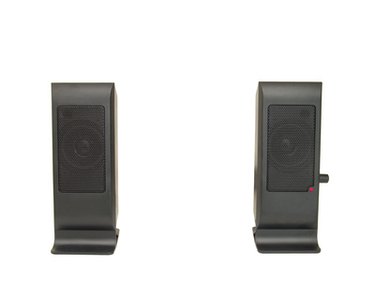
WAV files are much larger than MP3 files--sometimes up to 10 times larger. The WAV file format is an uncompressed format, while MP3s use compression methods to decrease file size. While the compression makes MP3s much smaller, some audio experts believe that this comes at the price of sacrificing audio quality and fidelity.
MP3 Compression
Video of the Day
MP3s are smaller than WAV files because they are compressed using lossy compression. Lossy compression means that some information is lost when the files are made smaller. Some authors, like John Atkinson at "Stereophile Magazine," claim that adversely affects audio quality. Others, like Peter Kirn at Create Digital Music say that, ideally, the lost data is inaudible and should have no effect on what the user hears. What is lost usually depends on the bitrate of the MP3. High-quality MP3s are less compressed; therefore, they discard less data, but they are usually larger in size than lower-quality MP3s.
Video of the Day
WAV Quality and Size
WAV files are uncompressed and are made using the same audio specifications that CDs use. This is why a WAV ripped from a CD can sound just as good as the original CD version; it is an exact copy. It's the lack of compression that makes the WAV file large. A three-minute MP3 encoded at a variable bit rate (VBR) averaging 211 kbps (kilobytes-per-second) can be around 5MB in size. A high-quality WAV file of the same song is nearly 10 times that at 45MB in size.
WAV Uses
Practical uses of WAV files are limited because of their massive size. They are most often used for short sound files, such as alert notifications in Windows. Their uncompressed nature also makes them an ideal file format for audiophiles and others who value audio quality over convenience. Historians prefer the WAV file to other compressed audio formats, as it preserves all of the original recording in its uncompressed format. It is also a preferred format because of its near-universal compatibility; Windows, Macintosh and Linux systems can all support the WAV file format.
Size and Restrictions
MP3s, and other compressed audio formats, exist because transporting large files like WAVs was not always possible. Transporting a large amount of WAV files on CD is nearly impossible, and bandwidth restrictions in the early days of the Internet made uploading and downloading large files like WAVs very inconvenient. While storage capabilities and bandwidths speeds have increased since then, many people still prefer smaller MP3 files to their larger WAV counterparts.
MP3 Uses
The MP3 file format is one of the most popular audio formats in the world. Music stores such as Napster and Amazon exclusively sell music as MP3s because of its wide compatibility and high compression ratio. Nearly all portable music players support the MP3 format, leading to most of them being generically labeled as "MP3 players." While most portable music players also support WAV files, the large file size is a limiting factor in their usage on those devices.